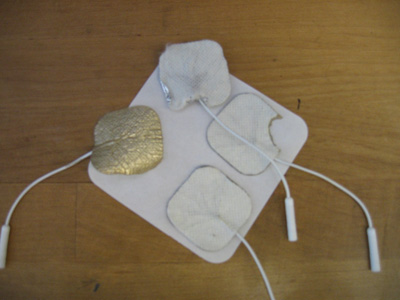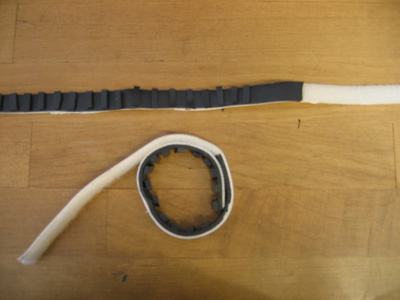new web: http://bdml.stanford.edu/pmwiki
TWiki > Haptics Web>StanfordHaptics > ArmTwister>InitialPrototypes (11 Jun 2007, MelodyWu? )
Haptics Web>StanfordHaptics > ArmTwister>InitialPrototypes (11 Jun 2007, MelodyWu? )
Initial Prototypes:
1. Big rings - The idea was to transpose the current rotational skin stretch device into a wearable device that encirles the entire arm. The end effectors are adjusted to fit different arm shapes and sizes. We found that this takes a long time to set up and the rings are too bulky and heavy that when the arm is moved pressure is felt on certain end effectors, which overshadows any sensation due to skin stretch/twisting. 2. Sorbothane belt - Since the big rings were too heavy and hard to set up, we experimented with materials that stick and conf
orm easily to different shapes. I was going to try to make holes in the sorbothane so that it could be worn like a watch, but it sticks really well to itself and my skin so I didn't have to. It seemed like the skin was twisting the most only at the point of force application (pulling) and less the farther you go from that point. I thought about using push-pull cables glued to the sorbothane to actuate the pulling motion.
2. Sorbothane belt - Since the big rings were too heavy and hard to set up, we experimented with materials that stick and conf
orm easily to different shapes. I was going to try to make holes in the sorbothane so that it could be worn like a watch, but it sticks really well to itself and my skin so I didn't have to. It seemed like the skin was twisting the most only at the point of force application (pulling) and less the farther you go from that point. I thought about using push-pull cables glued to the sorbothane to actuate the pulling motion.
 3. TENS electrodes - The pressure sensitive adhesive on the electrodes seemed to stick really well to skin and peel off easily without removing much arm hair.
3. TENS electrodes - The pressure sensitive adhesive on the electrodes seemed to stick really well to skin and peel off easily without removing much arm hair.
 4. Velcro-sorbothane belt - This goes along the same idea as the sorbothane belt (see above) but the sorbothane is actually not really stretched to wrap it around your arm; the velcro is bendable to fit the shape of different arms, and ensures that the sorbothane treads stay in contact with the skin. The stronger sensation is created with more, smaller sorbothane tread pieces, causing the tissue/fat in the arm to bunch up together when a twist is applied. We might need to investigate the sensation of bunching some more in trying to figure out what works and what doesn't.
4. Velcro-sorbothane belt - This goes along the same idea as the sorbothane belt (see above) but the sorbothane is actually not really stretched to wrap it around your arm; the velcro is bendable to fit the shape of different arms, and ensures that the sorbothane treads stay in contact with the skin. The stronger sensation is created with more, smaller sorbothane tread pieces, causing the tissue/fat in the arm to bunch up together when a twist is applied. We might need to investigate the sensation of bunching some more in trying to figure out what works and what doesn't.
 5. Double-sided sticky tape in addition to Velcro-sorbothane belt - The addition of double-sided sticky tape didn't seem to affect the overall sensations much; probably just really made sure the sorbothane treads were in contact with the skin at all times.
6. Different belt widths - My original belts were about 1" wide, which provided lots of contact area with the arm skin to create a twisting sensation. Cutting them in half to about 1/2" wide proved to be ok, but probably not as effective as the larger 1" width.
5. Double-sided sticky tape in addition to Velcro-sorbothane belt - The addition of double-sided sticky tape didn't seem to affect the overall sensations much; probably just really made sure the sorbothane treads were in contact with the skin at all times.
6. Different belt widths - My original belts were about 1" wide, which provided lots of contact area with the arm skin to create a twisting sensation. Cutting them in half to about 1/2" wide proved to be ok, but probably not as effective as the larger 1" width.
 -- MelodyWu? - 11 Jun 2007
-- MelodyWu? - 11 Jun 2007 Ideas, requests, problems regarding TWiki? Send feedback